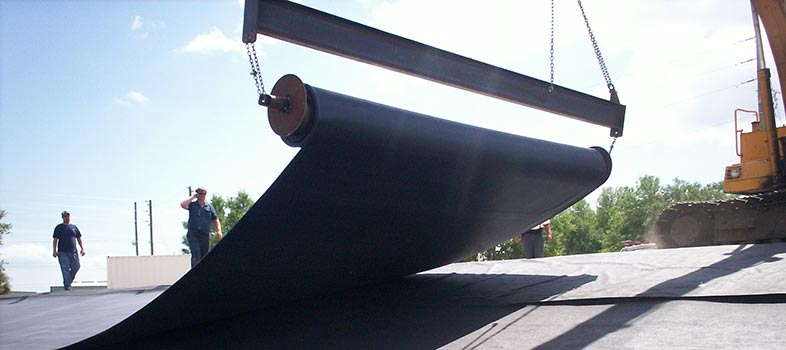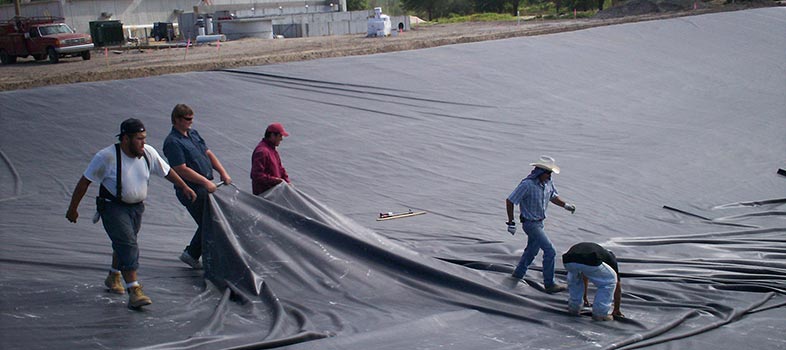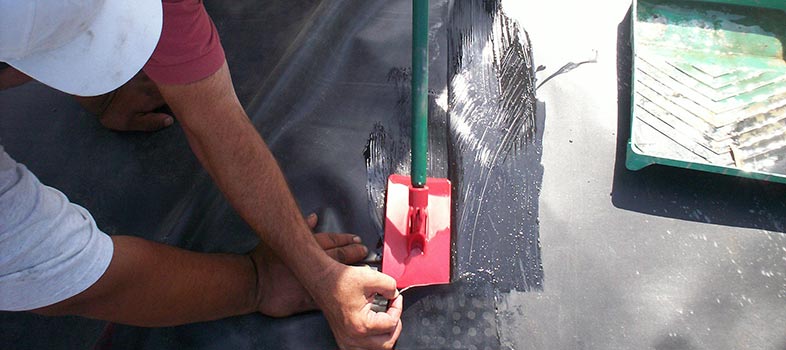Impermeable Liners
PVC Liner
A common thermoplastic resin, PVC (polyvinyl chloride) is used in wide array of manufactured products and is the most commonly specified lining material in the industry. It is a highly flexible, non-reinforced, cost-effective, waterproofing geomembrane with many uses and advantages for the user. PVC has excellent abrasion resistance and high puncture strength. It is resistant to a number of industrial chemicals, making it ideal for ponds, landfill caps, and wastewater facilities. Due to its high flexibility, PVC liners readily conform to sub grade contours and offer excellent interface friction without being textured. The use of a PVC liner prevents contaminants from entering groundwater sources or streams. In addition, it conserves potable water resources by preventing seepage loss.
-
- Decorative ponds and water features
- Fish hatcheries - Reservoirs
- Landfill caps
- Wastewater treatment facilities
- Golf course ponds
- Lakes and streams
- Irrigation Ponds
- Canals and channels
HDPE Liner
A petroleum based material, HDPE (high-density polyethylene) geomembrane is commonly utilized for solid waste and water containment applications due to its exceptional resistance to sunlight exposure and wide variety of chemicals. Among the other types of geomembranes, HDPE liners offer the lowest permeability for minimal seepage loss. It also resists cracking and thermal stress making it a reliable choice for various lining requirements whether it be for landfills, canals, decorative ponds, or animal waste containment.
-
- Agricultural pits and ponds
- Landfill containing and capping
- Mining applications
- Canals
- Decorative ponds and water features
- Wastewater facilities
- Solid waste facilities
- Geotextiles
- TenCate Mirafi Geotextiles N-Series & X-Series
- TenCate Mirafi Geotextiles S-Series
- TenCate Mirafi Geotextiles FW-Series
- TenCate Mirafi Geotextiles HP-Series & PET-Series
- TenCate Mirafi Geotextiles RSi-Series & H2Ri-Series
- TenCate Mirafi Geosynthetics MPV, MPG (PGM-G), and MPG4 (PGM-G4) Paving Fabrics
- Sediment Control & Construction Site BMPs
- Silt Fence
- Straw Wattles
- Floating & Staked Turbidity Barriers
- Applied Polymer Systems Polyacrylamides (PAM)
- Applied Polymer Systems Floc Logs
- Link Manifold System
- Floc Pit System
- Hach Portable Turbidimeter
- Dewatering Bags
- Curb Inlet Protection
- Drop Inlet Protection
- Sand, Sand-Cement & Rock Bags
- Rattle Grate Trackout Control
- FODS Trackout Control Mat
- Outpak Universal Portable Washout
- Erosion Control
- Hydroseeding Mulches
- North American Green Biodegradable Blankets
- North American Green Temporary Erosion Control Blankets
- North American Green Permanent Turf Reinforcement Mattings
- InstaTurf High Performance Erosion Control Mats
- Presto Geosystems Perforated GEOWEB
- Flexamat Concrete Mat Systems
- ARMORFORM Fabric-Formed Concrete Revetment Systems
- Maccaferri Reno Mattresses
- Tencate Geotubes for Shoreline Protection
- Geotextile Tubes for Lake Embankment
- Silt Fence
- Bioengineering Solutions
- Subgrade Stabilization & Load Support
- TenCate Mirafi Geotextiles RSi-Series & H2Ri-Series
- Tensar Biaxial (BX) Geogrids
- Tensar TriAx (TX) Geogrids
- Tensar InterAx (NX) Geogrids
- TenCate Mirafi Geosynthetics MPV, MPG (PGM-G), and MPG4 (PGM-G4) Paving Fabrics
- Presto Geosystems GEOWEB for Load Support
- Presto GEOPAVE
- Presto Geosystems GEOBLOCK & GEOBLOCK5150
- Presto GEOTERRA
- Presto GEORUNNER
- Soil Retention Drivable Grass
- EcoBlock (EB) Recycled Plastic Turf Block
- FODS Trackout Control System
- AGES Mud Mats
- Mud Control Grids
- Slope Reinforcement & Retaining Walls
- Drainage & Stormwater


